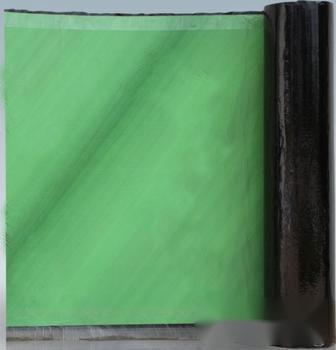I. Product Introduction:
YN-A750 Reactive Bonding Type Polymer Self-Adhesive Waterproof Membrane is a product developed by our company based on the principle of “hot melt pressure sensitive”. The formula combines multiple groups of “thermoplastic block copolymers, thermoplastic linear copolymers, and plasticizers” to create a “hot melt pressure sensitive” main agent, which is formulated to produce a “gel-like calcium silicate creep self-adhesive gel” that can creep at the hydration temperature of cement. This allows the self-adhesive gel on the surface of the membrane to plastically creep in an environment of cement hydration temperature, diffusing with the concrete interface and forming mechanical interlocking force.
It possesses the reactive activity characteristics of reactive adhesive sealants. When it reacts and bonds with cement gel on concrete surfaces, it forms a comprehensive and robust waterproof layer that is exceptionally tough, solving various issues such as hollowing and wrinkling that occur with ordinary self-adhesive waterproof membranes post-construction. This reactive adhesive waterproof membrane can be directly applied to damp substrates, with reliable waterproof performance, simple construction, and a long service life.
Waterproof Principle:
The self-adhesive gel coated on the surface of the YN-A750 reactive bonding type polymer self-adhesive waterproof membrane contains added “gel-like calcium silicate”. These particles undergo hydration at the surface of the creep self-adhesive gel layer to produce gel, which reacts with cement to form a hydration gel, penetrating each other and creating a network interpenetrating structure “IPN”, which firmly bonds the waterproof layer of the membrane to the concrete surface, eliminating the phenomenon of water seepage that traditional waterproof membranes often face. This waterproofing principle aligns with the emerging “skin-type” waterproofing concept both domestically and internationally.
II. Product Features:
1. High bonding strength, this material can bond with concrete substrates through a synergistic effect of chemical and physical reactions, with a bonding strength significantly greater than that of ordinary membranes;
2. The self-adhesive gel layer exhibits excellent self-healing and localized self-locking water properties, reacting with cement gel to form an interface sealing layer that prevents water seepage;
3. Excellent extensibility and tensile properties, adapting to deformations of structural substrates; if damaged (with hole diameters below 2mm), it can self-heal;
4. Self-locking at leak points, preventing dissemination and facilitating repairs;
5. The self-adhesive gel has excellent displacement performance, displaying superior adaptability to local structural deformations or cracks compared to ordinary self-adhesive membranes;
6. Soft material, easy to operate, suitable for various complex substrate constructions.
III. Applicable Scope:
1. Waterproof and impermeable measures for various underground projects, such as basements, subways, tunnels, etc.;
2. Roof waterproofing for industrial and civil buildings;
3. Waterproof projects for underground parking garage roofs, rooftop gardens, etc.;
4. Waterproof engineering for fire water tanks.
IV. Construction Key Points:
1. Base cleaning and moistening: Use tools such as brooms and shovels to thoroughly clean the dust and debris from the surface of the base. Dry bases should be pre-wetted, but standing water must be avoided.
2. Apply polymer cement-based elastic waterproof coating or polymer cement mortar: When using polymer cement-based elastic waterproof coating, the thickness is generally 2mm-3mm, forming a rigid-flexible composite waterproof system with the self-adhesive membrane. During the application of the coating, ensure it is compacted and smoothed. At the inner corners, a rounded corner with a radius of 50mm should be formed using cement mortar. The width of the polymer cement-based elastic waterproof coating should be wider than the membrane, with the short edges extending 100mm-300mm beyond the membrane, ensuring the flatness of the polymer cement-based elastic waterproof coating.
3. Strengthening treatment for detailed nodes: Before laying large area membranes, detailed nodes should be reinforced according to specification requirements.
4. Laying large area waterproof membranes: Remove the isolation material from the underside of the waterproof membrane and lay the membrane flat on the polymer cement-based elastic waterproof coating or cement mortar. The membranes should be laid in a parallel overlapping manner (in general, butt jointing is not recommended). The overlap seams should be no less than 60mm.
5. Lift slurry and expel air: Use a wooden trowel or rubber board to tap the surface of the membrane, expelling air from underneath the membrane to ensure tight adhesion with the polymer cement-based elastic waterproof coating or cement mortar.
6. Curing: After laying the membrane, it should be cured for 48 hours (the specific time depends on the environmental temperature, generally, the higher the temperature, the shorter the time required).
7. Overlap seam and sealing treatment: Use self-adhesive sealing strips to cover the joint areas. During operation, first remove the isolation membrane (or silicone oil release paper) from the overlapping area, and then stick the self-adhesive sealing strip. If the overlapping area is contaminated, it must be cleaned beforehand.
V. Precautions:
1. Packaging is rolled with plastic tape;
2. The membrane should be stored in a dry, ventilated environment, protected from sunlight, rain, and moisture;
3. Differently categorized and sized membranes should be placed flat separately, and the stacking height should not exceed 5 layers, without tilting or cross-pressing;
4. Under normal conditions, the shelf life is one year from the date of production.













